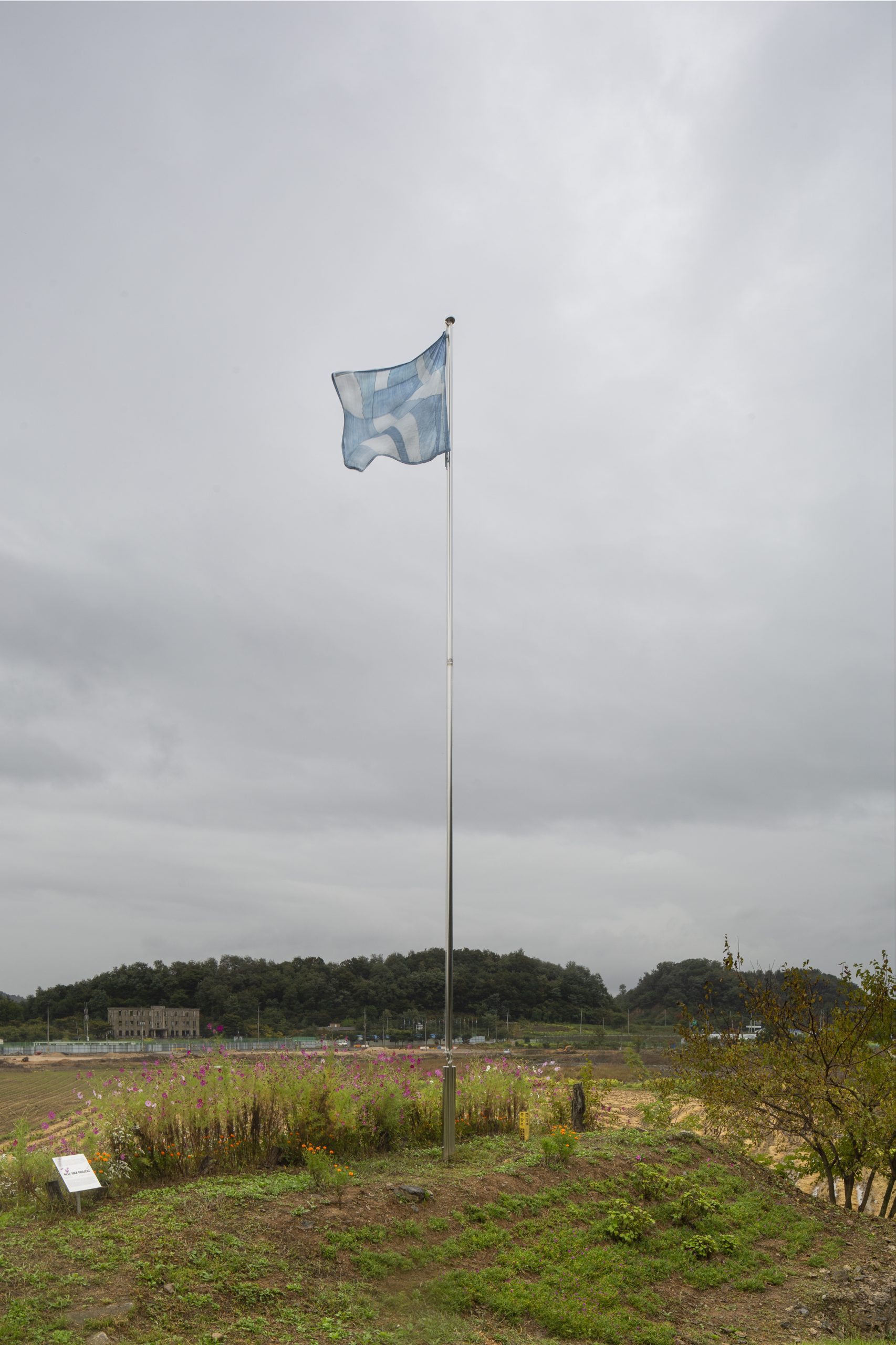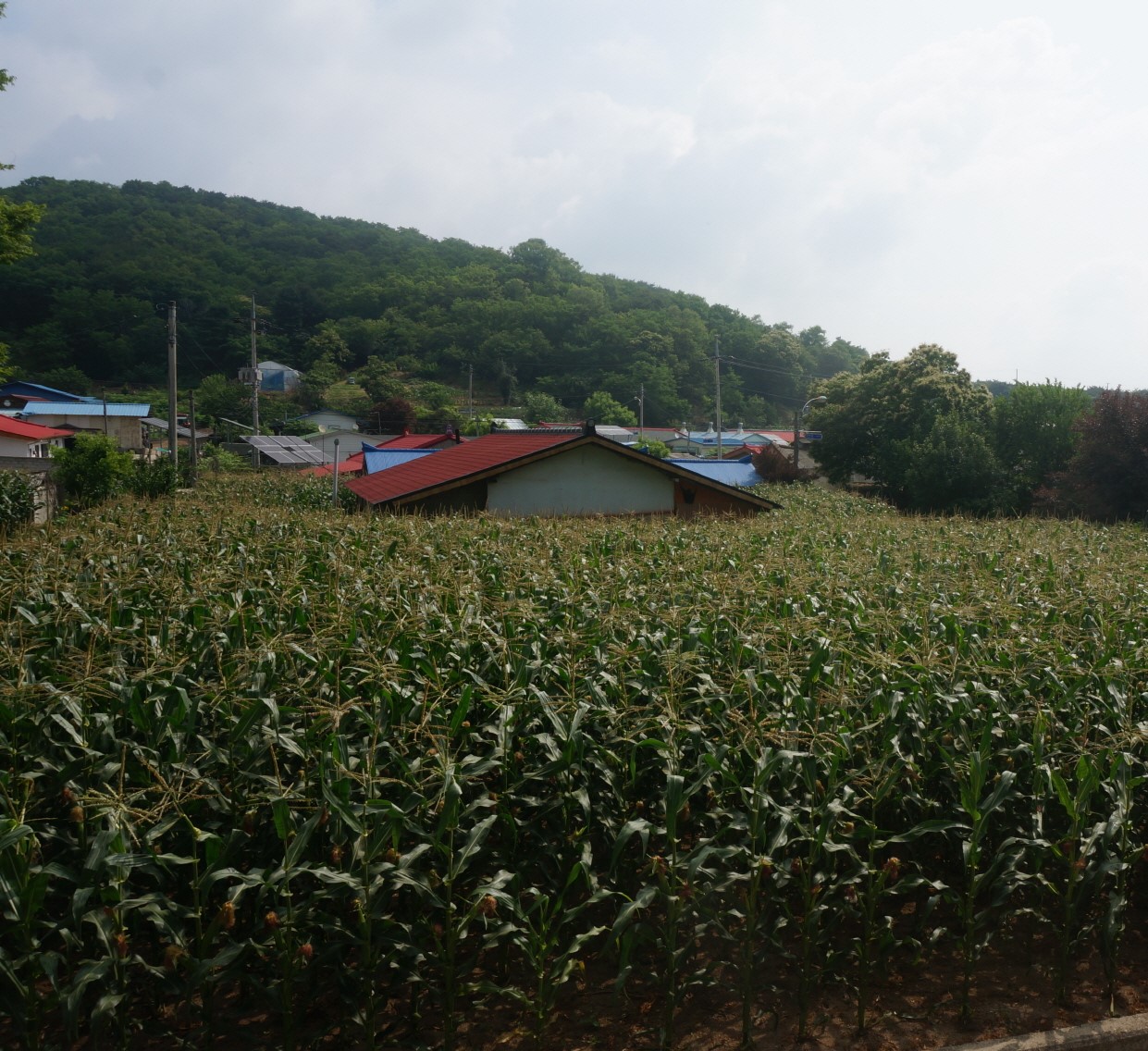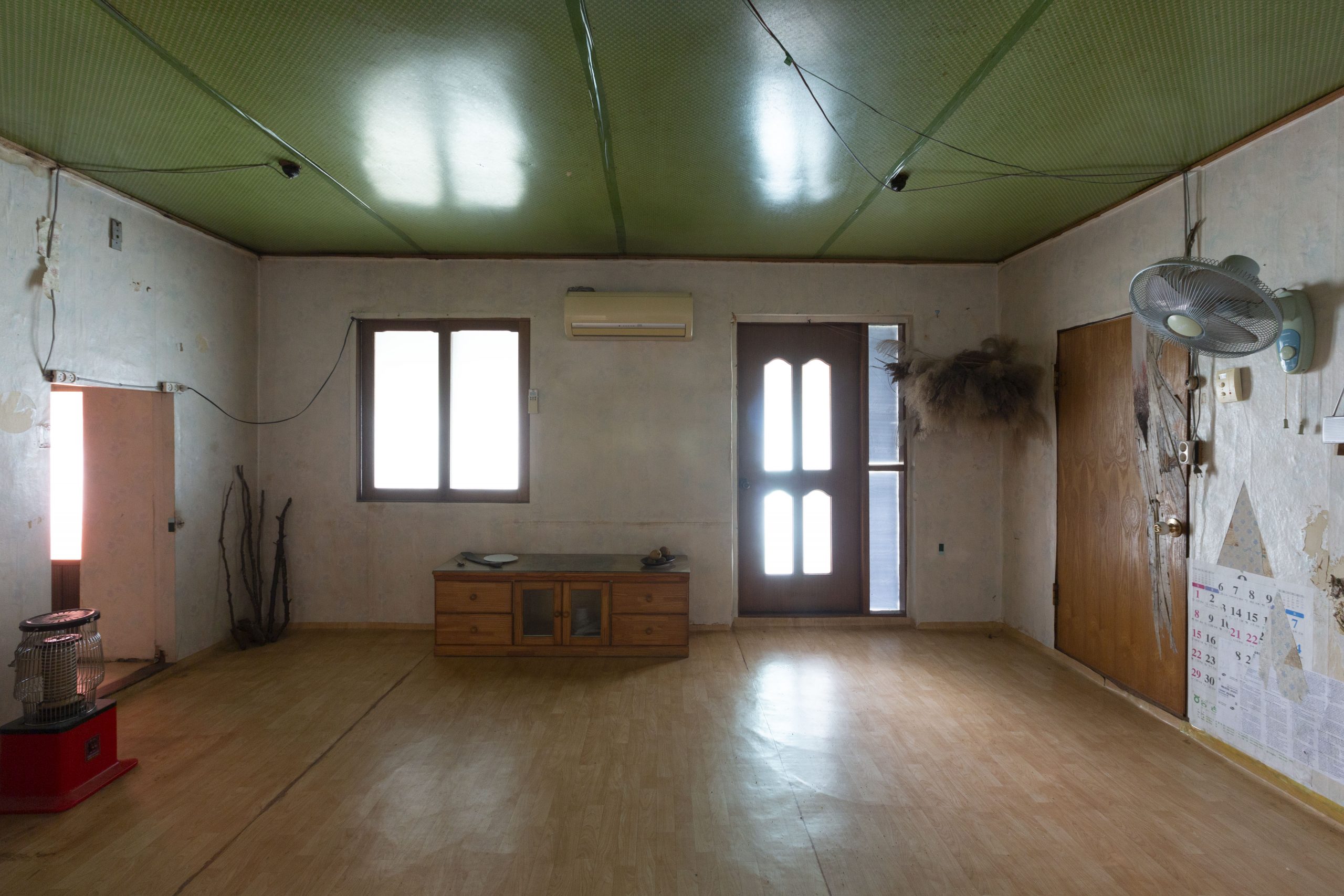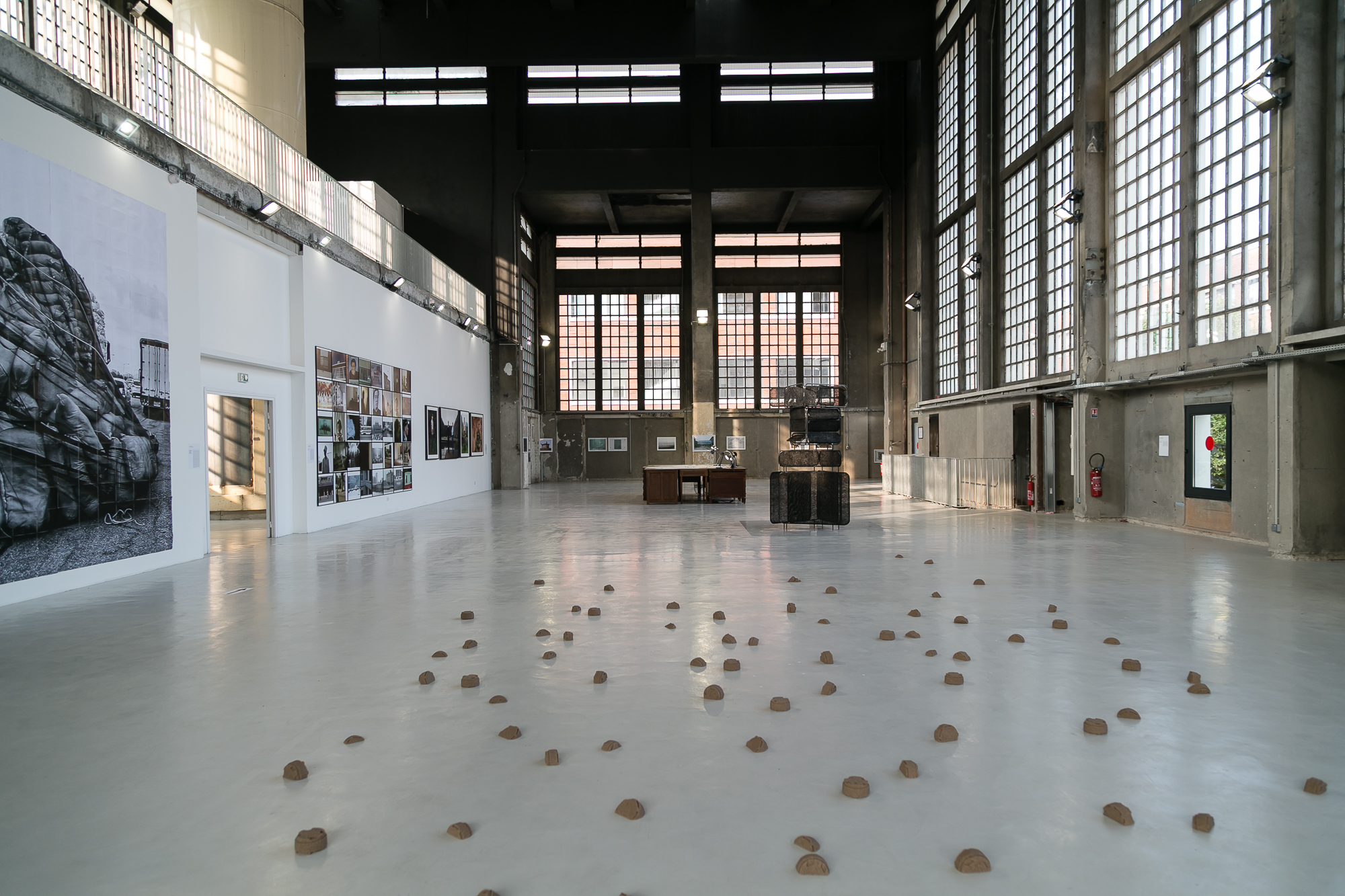Interdisciplinary explorations in history, geopolitics, sociology and nature in the Korean Demilitarized zone
Unpacking the Real DMZ Project with Sunjung Kim
Sunjung Kim’s ongoing Real DMZ Project sheds light on the Korean Demilitarized zone, a physical geographic symbol of the layered and nuanced divisions between North and South Korea. Through collaborative and interdisciplinary exhibitions, education programs and commissioned works, this project offers interrogations, insights and interpretations of border politics and forbidden landscapes.

Yeesookyung
You Were There, 2017
Rocks, 24K gold leaf, urethane paint, 320×300×170 cm
Installation view at Cheorwon, South Korea
Commissioned by the Real DMZ Project
Courtesy of the artist and the Real DMZ Project

Byron Kim
Flag, 2018
Installation view at Cheorwon, South Korea
Commissioned by the Real DMZ Project
Courtesy of the artist and Real DMZ Project
First, I hoped to raise awareness and knowledge about the division of Korea and thought it would be important to study and understand the historical contexts that led to the creation of the DMZ, including the complexities of the Korean War and the Cold War.
SOUTH SOUTH (SS): Could you please share a bit more about your own journey within the art world?
Sunjung Kim (SK): My early curatorial projects at Art Sonje Center centered on developing artists’ new productions in close collaboration with them. Then I became interested in art’s social role and started curating exhibitions in non-art spaces. I initiated and directed Platform Seoul, a contemporary art festival held annually from 2006 to 2011, which consisted of exhibitions mounted in a variety of venues including the historic former Seoul Station building and the former site of the Defense Security Committee of South Korea. The programs also included symposia and talk events focused on discourses, for example issues related to public art, nationalism, relationship between institutions and communities, and between artists and audiences. The Real DMZ Project started in 2012 and is ongoing.
SS: Please share more about how the idea for the Real DMZ Project came about?
SK: While I was working on the 2012 Gwangju Biennale as a Co-Artistic Director, I had a chance to visit Cheorwon upon the suggestion of Nancy Adajania, who, also as a Co-Artistic Director of the biennale edition, had proposed to do a research on the DMZ as part of the Gwangju project. It had a strong impact. After the research trip, I came up with ideas and plans for the Real DMZ Project, planning for it to be a ten-year-long project. First, I hoped to raise awareness and knowledge about the division of Korea and thought it would be important to study and understand the historical contexts that led to the creation of the DMZ, including the complexities of the Korean War and the Cold War. My second and third purposes were to explore and better understand North Korea and the border area as well. Furthermore, the DMZ’s ecosystem was among the Project’s research targets. For all of these reasons I thought a long-term project was necessary.
In Cheorwon, the Real DMZ Project organized exhibitions and workshops as well as establishing a residency program, inviting artists and commissioning new works there. Many of the commissions have been site-specific works, so people need to travel to Cheorwon to see them. Some are permanent productions, and of course, there are works that can travel. The artworks, exhibitions and education programs organized by the Real DMZ Project aim to explore and address a variety of issues including history, geopolitics, sociology, and nature.
SS: Please could you share more on the central thematic aims or lines of interrogation that propel the evolution of the project?
SK: As suggested above, the Real DMZ Project is interdisciplinary, and collaboration with people from diverse backgrounds and professions is essential. Communication with the people of Cheorwon is especially important, and this is one of the reasons why we started the Yangji-ri residency program there. The artists and researchers who have participated in the residency program have collaborated well with the local residents. At times it can be difficult to convince the local community who are not very familiar with contemporary art. Also, given the nature of the DMZ, many of our projects necessitate, and are not possible without, the cooperation of many organizations and institutions such as the military, the Ministry of Unification, and the United Nations. Communication with them is also very important.
SS: Who do you see as the audience or community for the iterations of the project?
SK: Our audience is broad, including those of the art world who travel all the way to Cheorwon and other venues to see the art, the citizens and soldiers of Cheorwon, and tourists and passersby who may unexpectedly encounter the artworks or exhibitions. I hope the Project can offer chances for them to think, albeit briefly, about the division of Korea.
SS: Could you please share more on the significance of this project taking place across different spaces and being iterated in different forms over a long period of time?
SK: The DMZ is only 30-40 minutes away from Seoul, but it is largely a forgotten place in our everyday reality. People have learned to forget about the division and the tragic war that is still pending. The Real DMZ Project aims to raise awareness and bring the issues to our everyday consciousness. Iterating the border issues in diverse forms in different locations can help us approach the DMZ from diversified perspectives and can bring us closer to the border issues that have been predominantly political and military. I myself did not know much about the complications around and about the DMZ, so I felt long-term research was necessary.
SS: Could you please share more about the curatorial approach for the overall project?
SK: It was started with a focus on the DMZ, the border area, its histories, and other related issues. Eventually the Project’s scope extended to include borders around the world and non-territorial boundaries as well. For example, in 2015, Aernout Mik presented Osmosis and Excess (2005), a work on the Sand Diego-Tijuana border, alongside the Real DMZ Project-commissioned production, Ice Cream Hill (2014-15), filmed in Cheorwon.
SS: Could you please share more about your thinking for the large-scale exhibition DMZ—featuring works of 61 international artists—at Cultural Station Seoul 284, and the importance of including artworks as well as archival materials from the project?
SK: In light of 2018’s dynamic progress in inter-Korean relations, the exhibition in 2019 sought to explore the Korean DMZ comprehensively by illuminating its many sides and stories. The exhibition consisted of 5 sections. The first section was dedicated to artists’ and designers’ propositions for the future of the border area, and the second section to artworks exploring the current state of the DMZ. The third section focused on addressing the life of soldiers and residents, and as part of this section, curator Keum Hyun Han organized an archive of photographs of Korean and American soldiers from the 1950s through the 1970s. For the fourth, “painting” section, curator Haeju Kim was able to get hold of some 50 works of painting that depict the border area, and this section also included archive materials from DMZ-themed art exhibitions. The fifth section, curated by Kyung Jin Zoh, a scholar of environmental studies, presented a reconstruction of the DMZ’s ecological profile including rare plants.
SS: Could you please share more your curatorial frame for Negotiating Borders (2019) and the artists commissioned to produce work?
SK: It was an exhibition mounted at the Korean Cultural Center UK, and consisted of works that were available for travel from South Korea. Its sister exhibition, initially planned to be held in Germany’s Wolfsburg, has been canceled due to the COVID-19 pandemic. While the Real DMZ Project continues to commission new productions, mostly site-specific as mentioned earlier, the Real DMZ Project’s overseas exhibitions, such as The Timeshare Project (Kunsthal Aarhus, Denmark, 2017) and Negotiating Borders (Centre Culturel Coréen, France, 2020), were usually curated around works that could travel. Organized at the time of shifting dynamics in international relations in light of the 2018 inter-Korean summits, the exhibition presented the DMZ via shifting positions. While the DMZ and North Korea are territories forbidden to most South Koreans, Heinkuhn OH’s photographs of soldiers and Joung-Ki Min’s and Jung Heun Kim’s paintings of the border-area landscape exemplified how the South Korean artists approached and “looked at” the divided Korea. Photographic works by Seung Woo Back and NOH Suntag were produced based on their actual visits to North Korea, a rare chance for South Korean citizens. Kyungah Ham’s work contains embroideries by North Korean seamstresses, contacted indirectly through brokers. The exhibition also presented works by artists and designers that propose future scenarios for the DMZ, for example, Seung H-Sang’s design of a monastery for birds and Lee Bul’s suggestion of transforming bunkers into sculptural monuments.

Adrián Villar Rojas
From the series El momento más hermoso de la guerra, 2016–ongoing
Installation view at Yangji-ri Village, South Korea
Commissioned by the Real DMZ Project
Courtesy of the artist and REAL DMZ PROJECT

Adrián Villar Rojas
From the series El momento más hermoso de la guerra, 2016–ongoing
Installation view at Yangji-ri Village, South Korea (internal view)
Commissioned by the Real DMZ Project
Courtesy of the artist and REAL DMZ PROJECT

Exhibition view: Negotiating Borders, Fondation Fiminco, Paris, 2020. Courtesy of KOFICE, Fondation Fiminco and Real DMZ PROJECT
SS: You are also the president of the Gwangju Biennale Foundation. Could you please share more on what the important considerations are for you in positioning the biennale within the global art ecosystem? Do the conversations and provocations from the Real DMZ Project seep into your approach for the biennale?
SK: My experience with the Real DMZ Project was influential in deciding the theme for the 12th Gwangju Biennale (2018) which was “Imagined Borders.”. The Gwangju Biennale was inaugurated in 1995 as Asia’s first biennale. The global art ecosystem has changed since then, and the changes need to be considered and reflected in the directions the Foundation needs to pursue. That’s what I’m trying to do.
SS: Could you perhaps give some insight into the framing for the now postponed biennale? What are you most excited about?
SK: The Artistic Directors Defne Ayas and Natasha Ginwala’s directorial approach is very interesting. Under the title “Minds Rising Spirits Tuning” they are delving into a wide range of “intelligences of the mind” beyond science or technological intelligence, such as cosmologies, animism, and indigenous knowledge. The edition’s opening has been postponed due to the pandemic, and the schedule may change according to the COVID-19 situation.
